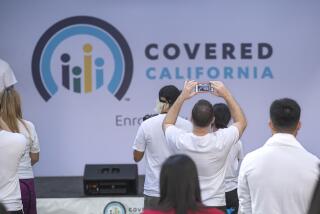Covered California begins ad blitz in final enrollment weeks
With less than a month left for enrollment in Obamacare, California’s insurance exchange is applying a major dose of peer pressure.
In a new TV ad blitz, recent enrollees extol the benefits of having coverage for checkups or a serious illness. A man plays soccer with his sons, a musician carries his guitar down the street. “I’m in,” young, fit-looking people say. “Are you in?” the announcer asks.
This new marketing marks a more direct appeal to millions of uninsured Californians before open enrollment ends March 31. After March 31, people can’t enroll in most health plans again until late fall.
It’s still a hard sell for a healthcare law that remains largely unpopular, even among many people who stand to benefit from it the most.
A recent Kaiser Family Foundation poll found that 22% of uninsured people surveyed had a favorable view of the Affordable Care Act. But 56% of people without coverage view the law unfavorably.
Overall, 4 million Americans have enrolled in health plans so far through federal and state exchanges. That’s well short of the Obama administration’s original goal of 7 million enrolled by the end of March. To help boost turnout, President Obama will participate in a town hall meeting Thursday geared to Latinos.
The Covered California exchange has signed up 828,000 people through mid-February and already exceeded its estimated enrollment. But the exchange has fallen short in certain regions, such as Riverside and Fresno, and with key groups such as Latinos and young people.
California plans to spend $80 million through the end of this year on media and marketing, drawing on federal grant money. Covered California opened its advertising in the fall with a general introduction to the state exchange and the healthcare law under the tagline “Welcome to a new state of health.”
The ads showed people driving along California’s signature coastline with signs that read “Welcome to getting care” and “Welcome to feeling at ease.” Other commercials played on the fears of those without health insurance, showing scenes of car crashes, bike accidents and crowded emergency rooms.
Some health-policy experts and advertising executives said the initial ads were too bland.
“I thought the initial round of commercials were a little too vague on what Covered California is,” said Gerald Kominski, director of the UCLA Center for Health Policy Research.
The new commercials come across as more personal and may better connect with the target audience, said Los Angeles media consultant Sheri Sadler.
“The most successful campaigns hit me where I can relate to the why, or who, or what, to get the best responses,” she said. “The ads that just took us through our great state of California didn’t make me want to do anything.”
The new ads will also emphasize that the exchange’s certified enrollment counselors and insurance agents offer help that is free and confidential.
In its outreach to young people, Covered California has tried to be more lighthearted in a line of “millennial cards” handed out at college campuses and other enrollment events.
One card features rows of drinking glasses with the message “A round of shots for less than a round of shots.” Others read, “X-rays for less than video games” and “Prescriptions for less than pedicures.”
The marketing in other states has often been even edgier.
In an ad from a Colorado group supporting the health law, a woman shows off her birth control pills and eyes the man next to her, with the caption: “Let’s hope he’s as easy to get as this birth control. My health insurance covers the pill, which means all I have to worry about is getting him between the covers.”
New ads for Washington state’s health exchange follow two fictitious rappers, decked out in satin, fur and gold chains, as they talk to people about their health plans.
Another group created ads intended to appeal to young women that featured singing dogs and cats pleading with their owners to get covered. In December, Obama tweeted an ad that was widely mocked, showing a young man in a onesie, alongside the caption “Wear pajamas. Drink hot chocolate. Talk about getting health insurance.”
Health insurers are also stepping up their advertising. Health Net Inc. has plastered billboards and buses across Los Angeles with ads proclaiming “We are your Health Net” alongside photos of a child with a fever or a person with a broken arm.
Kaiser Permanente, the state’s largest HMO, drafted two pro basketball stars to pitch health coverage to young people. Chris Paul of the L.A. Clippers and Stephen Curry of the Golden State Warriors appear in “Own Now” ads for Kaiser urging young people to take chances in life, but not with their health and well-being.
All those ad dollars have missed Santa Ana resident Luis Garcia, 23. He said he hasn’t seen any of the Obamacare advertising. He recently lost his job and said he would like to have health coverage.
But he knows about the healthcare law only from what he’s heard from friends, such as there’s some kind of penalty if he doesn’t sign up. He said he wasn’t aware of any deadline to enroll.
“But I’m interested,” he said.
Most Americans are required by the Affordable Care Act to have health insurance starting this year. Without coverage, they face a penalty in 2014 of $95 per adult or 1% of their household income, whichever is greater.
More than effective marketing, some health-law supporters say the biggest challenge for Covered California is handling the expected influx of applicants in the final weeks.
In late December, the exchange struggled to handle hundreds of thousands of applications from people rushing to get coverage by Jan. 1. More recently, Covered California suffered a five-day website outage and nearly 15,000 people were forced to redo their applications.
soumya.karlamangla@latimes.com







